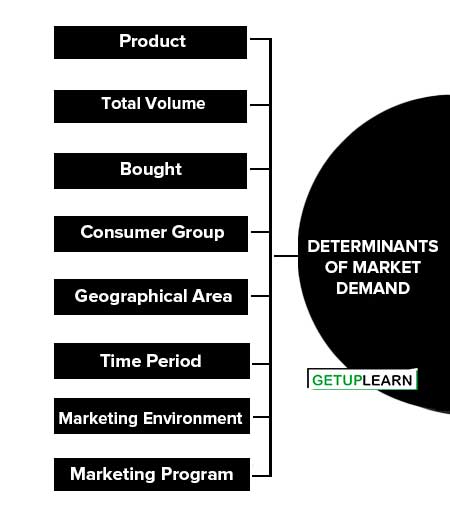Table of Contents
What is Market Demand?
Market demand for a product is the total volume that would be bought by a defined customer group in a given geographical area in a defined time period in a defined marketing environment under a defined marketing program.
Determinants of Market Demand
There are 8 determinants of market demand as described herein:
- Product
- Total Volume
- Bought
- Consumer Group
- Geographical Area
- Time Period
- Marketing Environment
- Marketing Program

Product
Market demand measurement requires defining the scope of the product class. A tin-can manufacturer has to define whether its market is all metal-can users or all container users. It depends on how the manufacturer views its opportunities for penetrating adjacent markets.
Total Volume
Market demand can be measured in terms of physical volume, dollar volume, or relative volume. The Indian market demand for automobiles may be described as 10 million cars or Rs. 1000 crores. The market demand for automobiles in the New Delhi area can be expressed as say 2.5 percent of the nation’s total demand.
Bought
In measuring market demand, it is important to define whether “bought” means the volume ordered, shipped, paid for, received, or consumed. For example, a forecast of new housing for the next year usually means the number of units that will be ordered, not the number that will be completed (called housing starts).
Consumer Group
Market demand may be measured for the whole market or for any segment(s). Thus a, steel producer may make separate estimates of the volume to be bought by the construction industry and by the transportation industry.
Geographical Area
Market demand should be measured with reference to well-defined geographical boundaries. A forecast of next year’s passenger automobile sales in Haryana will vary depending on whether the boundaries are limited to Haryana or include Chandigarh also.
Time Period
Market demand should be measured with reference to a stated period of time. One can talk about the market demand for the next calendar year, for the coming five years, or for the year 2000. The longer the forecasting interval, the more tenuous the forecast.
Every forecast is based on a set of assumptions about environmental and marketing conditions and the chance that some of these assumptions will not be fulfilled increases with the length of the forecast period.
Marketing Environment
Market demand is affected by a host of uncontrollable factors. Every forecast of demand should explicitly list the assumptions made about the demographic, economic technological political, and cultural environment. Demographic and economic forecasting are well-developed.
Technological forecasting is coming into its own, but political and cultural forecasting is still in its infancy. Much interest in the whole subject of predicting future environments is being stimulated by futurists. At the same time, Levitt has cautioned: “The easiest kind of expert to be is the specialist who predicts the future. It takes only two things: imagination and a good command of the active verb.”
Marketing Program
Market demand is also affected by controllable factors, particularly marketing programs developed by the sellers.
Demand in most markets will show some elasticity with respect to industry price, promotion, product improvements, and distribution efforts. Thus a market demand forecast requires assumptions about future industry prices, product features and marketing expenditures.
FAQs About the Determinants of Market Demand
What are the determinants of market demand?
The following are the determinants of market demand: 1. Product 2. Total Volume 3. Bought 4. Consumer Group 5. Geographical Area 6. Time Period 7. Marketing Environment 8. Marketing Program.
